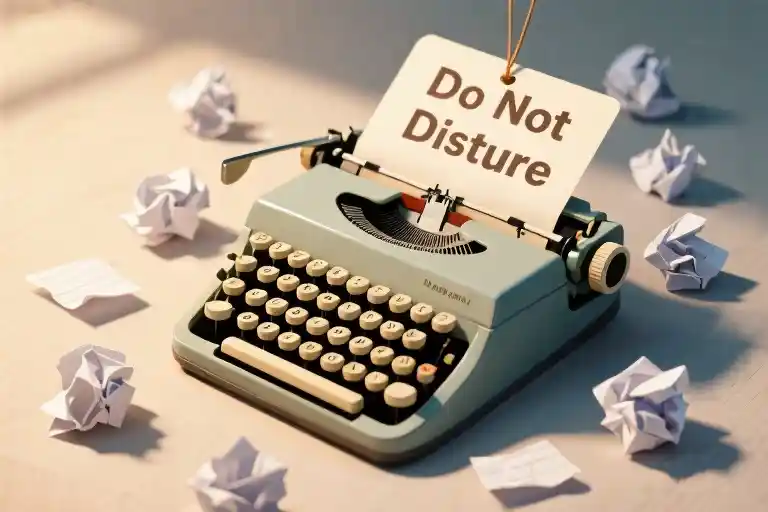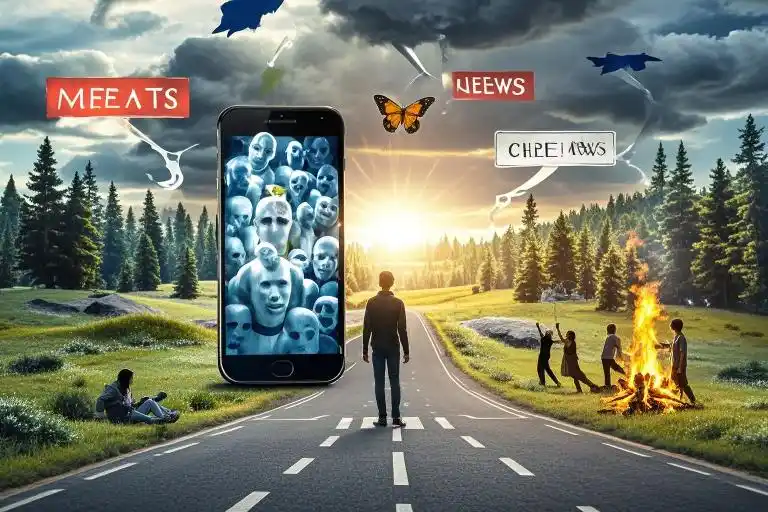The seventh time I deactivated my Facebook account, I found myself staring at a biography of Truman Capote on my bookshelf. A disturbing realization hit me: the only difference between my “scathing social commentary” and his drunken ramblings was typesetting. At least his incoherent midnight musings eventually became breakfast talk at Tiffany’s, while mine just earned me a permanent spot in someone’s ‘toxic acquaintance’ mental folder.
Social media in the 21st century has become the great equalizer of wit – reducing what might have been Oscar Wilde-worthy satire in another era to mere digital heckling. The same acidic tongue that could have secured me a newspaper column in 1923 now just gets me muted in group chats. There’s something tragically comedic about realizing your most profound Facebook post reads exactly like Dorothy Parker’s rejected cocktail napkin scribbles – except without the gin-stained charm.
This isn’t to romanticize those legendary sharp-tongued writers of yore. Most were emotional train wrecks who used alcohol as both muse and medication. The roster of celebrated wits who weaponized their words reads like a temperance movement pamphlet: Capote drowning in his own bitterness, Wilde’s brilliant flame extinguished too soon, Parker’s legendary one-liners often slurred. They all seemed to share the same career trajectory – early success, followed by decades of creative burnout sustained only by liquor and lingering fame.
Yet here’s the uncomfortable truth: social media has democratized this particular brand of self-destructive brilliance. We’ve created an ecosystem where anyone with a smartphone and superiority complex can play at being the next H.L. Mencken – minus the actual writing talent. The platforms reward our worst impulses, turning what might have been thoughtful critique into performative outrage. My Facebook feed had become less a salon of ideas and more an asylum where we’re all both inmates and guards.
Perhaps Calvin Trillin had the right approach – that rare combination of Midwestern pragmatism and New Yorker wit. The man could eviscerate with words while still making it home for dinner. Maybe that’s the real social media detox we need: not just logging off, but learning that true insight doesn’t require drawing blood with every keystroke.
When Moral Superiority Meets the Like Button
It started, as most regrettable social media moments do, with organic vegetables. There I was, scrolling through Facebook on a Tuesday evening when a childhood friend posted about “the criminal markup on kale at Whole Foods.” Before rationality could intervene, my fingers had crafted a 300-word manifesto on agricultural economics, complete with footnoted studies about farm subsidies and three separate metaphors comparing grocery shopping to late-stage capitalism. By the time I tapped “Post,” my cheeks burned with that peculiar warmth that comes from equal parts conviction and embarrassment.
What followed was textbook social media theater:
- The Immediate Backlash: A yoga instructor from Portland called my analysis “reductive” (fair).
- The Unlikely Ally: My cousin’s libertarian boyfriend chimed in with “PREACH” (concerning).
- The Personal Attack: Someone asked if I’d ever actually grown food (I haven’t).
Yet for those first 17 minutes when the likes rolled in, I felt it – that intoxicating cocktail of validation and virtue. The neurological equivalent of biting into a perfectly ripe peach while someone applauds. This wasn’t just about vegetables; it was about performing intelligence, about weaponizing information to claim higher ground.
The Psychology Behind Our Digital Pulpits
Research from the Journal of Experimental Social Psychology reveals what my kale rant demonstrated: moral grandstanding activates the same reward pathways as financial gain. When we:
- Frame opinions as moral imperatives (“Only fools ignore food deserts!”)
- Use “we” statements to imply collective wisdom (“As a society, we must recognize…”)
- Deploy statistics like ammunition (“83% of studies show…”)
…our brains receive microdoses of dopamine not from being right, but from being recognized as right. The platform’s design exacerbates this:
| Platform Feature | Psychological Effect |
|---|---|
| Like/Share buttons | Quantifiable social approval |
| Algorithmic sorting | Rewards extreme positions |
| Asynchronous replies | Eliminates real-time accountability |
From Debate to Performance Art
What began as genuine concern about food systems had morphed into what linguists call “convincing oneself in public” – the phenomenon where arguments become less about persuasion and more about reinforcing one’s self-image as an enlightened thinker. My organic vegetable tirade followed the classic arc:
- The Opening Salvo: A seemingly innocuous comment (“Actually, the data suggests…”)
- The Escalation: Denser jargon and cited sources (to signal credibility)
- The Moral Crescendo: Framing disagreement as ethical failure (“This mindset is why climate change…”)
By the end, I wasn’t discussing produce; I was auditioning for the role of “Public Intellectual” in the theater of my own newsfeed.
The Midwestern Alternative
This pattern might explain why Calvin Trillin – arguably as sharp-tongued as Dorothy Parker – avoided becoming a social media cautionary tale. His Missouri roots instilled what psychologists call “argumentative humility”: the ability to critique without needing an audience. Where my Facebook posts screamed “Look how much I know!” Trillin’s best barbs were often whispered to friends over pie.
Perhaps the healthiest response came when I revisited that vegetable thread weeks later. Between the deleted comments and my own cringe-induced memory suppression, all that remained was a single reply from my grandmother: “Honey, just eat more carrots.” Sometimes wisdom doesn’t need a citation.
When Wit Was Art, Not Just Noise
There was a time when a well-placed barb could cement your reputation as a cultural luminary. Oscar Wilde’s quip, “I can resist everything except temptation,” would circulate through London drawing rooms, earning him both notoriety and admiration. Fast forward to today, and that same level of wit on Twitter might earn you a pile-on of outraged quote-tweets and accusations of privilege.
The fundamental nature of sharp commentary hasn’t changed – what’s changed is the medium and the audience. In Wilde’s era, a cutting remark had to travel through slower channels: printed in newspapers, repeated in letters, shared in person at social gatherings. This built-in delay acted as a filter, allowing only the most incisive observations to survive and spread. The modern social media landscape lacks these natural buffers. A thought forms, fingers type, and within seconds your half-formed opinion is launched into the digital ether, where it takes on a life of its own.
Consider two parallel scenarios:
- 1895: Wilde delivers his famous line about youth thinking money important and age proving it so at a dinner party. The remark spreads through London society, gaining polish with each retelling. Those who might take offense aren’t present to hear it, and by the time it reaches them, the social context softens its edge.
- 2023: An anonymous Twitter user posts, “People who say money doesn’t buy happiness just aren’t spending it right.” Within hours, the tweet is screenshotted and shared across activist circles with captions like “This is why we need wealth redistribution” and “Check your privilege.”
The words might carry similar meaning, but their reception couldn’t be more different. This shift reflects broader changes in how we conduct public discourse. The salon culture that nurtured Wilde’s style of wit depended on shared social norms, established hierarchies, and the physical presence of conversation partners – all factors that moderated expression. Digital platforms remove these moderating forces while amplifying the reach of every utterance.
Three key differences define this evolution:
- The democratization of audience: Where Wilde spoke to a self-selecting group who sought out his particular brand of humor, social media exposes every comment to potential audiences who didn’t opt in and might lack context.
- The compression of time: The gap between thought and publication has shrunk from days (for newspaper columns) or hours (for salon conversations) to seconds, removing the cooling-off period that often prevents regrettable remarks.
- The permanence of the temporary: Offhand comments that would have evaporated into the air at a party now persist indefinitely in searchable databases, available for reinterpretation out of their original context.
This isn’t to suggest we should mourn the loss of some golden age of civilized discourse. Many of those celebrated wits were terrible people by modern standards, and their verbal jousting often masked genuine cruelty. But understanding how the mechanics of public conversation have changed helps explain why attempts to transplant their style into digital spaces so often backfire.
The challenge for those of us who appreciate sharp humor but don’t want to become social media pariahs is to adapt our expression to the new reality. This might mean:
- Developing thicker filters: Applying the “would this be funny if I had to say it to someone’s face” test before posting
- Embracing delayed gratification: Writing scathing observations in a private journal rather than a public feed
- Learning new forms: Recognizing that some styles of wit simply don’t translate well to digital mediums
Perhaps Dorothy Parker would have thrived on Twitter. Maybe Oscar Wilde would have built a massive TikTok following. But given how many contemporary writers have crashed and burned trying to replicate their approaches online, I suspect even they would have needed to adapt their craft to our new communication landscape.
The ‘Cheap Bar’ Effect of Facebook
Scrolling through Facebook often feels like walking into a dive bar at 2am – the lights are too bright, the conversations too loud, and everyone’s convinced they’re the smartest person in the room. The platform’s design practically encourages this environment, creating what psychologists call ‘online disinhibition effect’ where normal social restraints disappear faster than free office donuts.
How Algorithms Reward Outrage
MIT’s Social Media Lab found that angry posts spread three times faster than neutral content. The platform’s algorithm operates like a bartender who only serves the loudest patrons – the more extreme your opinion, the more ‘free drinks’ (likes, shares, comments) you receive. Before you know it, your mild take about pineapple on pizza evolves into a 500-word manifesto about culinary colonialism.
This creates a vicious cycle:
- You post something mildly controversial
- The algorithm shows it to people most likely to disagree
- Angry responses trigger your defensive instincts
- You double down with more extreme language
- Repeat until your thread resembles a 19th-century duel with keyboards instead of pistols
The Keyboard Warrior Psychology
Anonymity transforms us in strange ways. That same person who’d politely nod at a coworker’s questionable opinion in the break room suddenly morphs into a digital Cicero when protected by a screen. Studies show the brain processes online interactions differently – without facial cues and tone of voice, we default to interpreting everything as hostile.
Social media becomes the psychological equivalent of bottom-shelf tequila:
- Fast high: Immediate dopamine hit from likes/shares
- Quick crash: Subsequent shame or defensiveness
- Long-term damage: Erodes real-world communication skills
Breaking the Cycle
Recognizing these mechanisms is half the battle. When you feel that familiar urge to type ALL CAPS RESPONSES, try these bartender-approved alternatives:
- The 24-hour rule: Write your rant in Notes app, sleep on it
- Perspective shift: Ask “Would I say this at Thanksgiving dinner?”
- Energy redirect: Turn the rant into a blog post or journal entry
Like any good bartender cutting off an intoxicated patron, sometimes the platform itself needs intervention. Tools like:
- News Feed Eradicator (replaces feed with inspirational quotes)
- SelfControl app (blocks social media during set hours)
Because let’s face it – if Oscar Wilde had faced modern algorithms, even he might have thought twice before tweeting “I can resist everything except temptation” at 3am after his third martini.
From Keyboard Warrior to Diary Dabbler: A Detox Guide for the Socially Conscious
Let’s face it—quitting social media cold turkey is about as sustainable as Oscar Wilde’s bank balance. The real challenge isn’t deleting your accounts, but rewiring those neural pathways that equate scrolling with satisfaction and ranting with relevance. Having cycled through seven Facebook deactivations myself, I’ve compiled three surprisingly practical strategies that don’t require moving to a Thoreau-style cabin (though keeping one as backup isn’t a bad idea).
1. The Self-Addressed Anger Email
When you feel that familiar surge of moral superiority bubbling up—perhaps because someone dared to call Pride and Prejudice “overrated”—open your email client and compose your magnum opus… to yourself. Set a 24-hour delay before it reaches your inbox. This digital cooling-off period serves multiple purposes:
- Neuroscience bonus: The amygdala’s anger response typically subsides within 20 minutes (Journal of Cognitive Neuroscience, 2018)
- Reality check: Your “brilliant takedown” often reads like a sleep-deprived manifesto in daylight
- Creative outlet: These unsent letters become fascinating psychological artifacts (future memoir material, perhaps?)
Pro tip: For extra accountability, schedule these emails to auto-forward to your best friend if you don’t manually cancel them. Nothing motivates self-editing like the threat of real-world consequences.
2. Cultivate Deliberately Dull Feeds
Social media algorithms thrive on outrage—MIT research shows angry posts spread 3x faster. Counteract this by following accounts that would bore Dorothy Parker to tears:
- Regional weather stations (“Partly cloudy with 30% chance of existential dread”)
- Niche hobbyists (The International Society of Spoon Carvers has surprisingly serene content)
- Government agencies (FDA recalls: dramatic without being toxic)
This isn’t about depriving yourself, but creating mental white space. Think of it as cognitive cross-training—you’ll develop new neural muscles for patience and perspective.
3. Host Analog Salons (Pajamas Optional)
The 19th-century literati had the right idea with their intellectual gatherings, minus the gender exclusivity and tuberculosis. Modernize the concept with:
- Theme nights: Debate whether Hemingway would’ve used TikTok (evidence suggests: yes, disastrously)
- Creative constraints: All opinions must be delivered in iambic pentameter
- Safe words: When discussions get heated, someone yells “Wilde card!” and everyone recites bad poetry
These gatherings satisfy our innate craving for intellectual sparring without the permanence (and potential HR consequences) of digital footprints. As an added bonus, real-time facial expressions provide much-needed feedback that no emoji can replicate.
The Midwestern Alternative
For those who find even these steps too theatrical, consider Calvin Trillin’s Missouri-born approach: humor that punctures pretension without drawing blood. His secret? Grounding every observation in tangible human experience—something we lose when typing into the algorithmic void.
Next time you reach for your phone to deliver that perfect zinger, ask: Is this Wildean wit or just sleep-deprived spite? Your future self (and possibly your liver) will thank you.
The 24-Hour Rule: Saving Yourself from Social Media Regret
We’ve all been there—typing out a fiery response to some innocuous Facebook post at 2 AM, convinced our words will deliver the perfect blend of wit and withering critique. By morning, that masterpiece morphs into cringe-worthy evidence of poor judgment. This phenomenon isn’t new; historians could probably trace similar impulses in Oscar Wilde’s unpublished drunken letters. The difference? Wilde’s scribbles stayed in his drawer, while our digital outbursts live forever in someone’s screenshot folder.
Why the Delay Works
Neuroscience explains why immediate reactions often backfire. When emotionally charged, our amygdala hijacks rational thinking for about six hours—plenty of time to craft regrettable hot takes. The 24-hour email rule creates a cooling-off period where:
- Adrenaline fades: That urgent need to “set the record straight” dissipates
- Perspective emerges: Re-reading reveals tone-deaf phrasing invisible in the heat of the moment
- Alternatives appear: Often, the best response is no response at all
Tech leaders like Jack Dorsey swear by this practice. Twitter’s co-founder famously admitted delaying tweet drafts overnight saved him countless PR disasters.
Implementing Your Digital Pause Button
Turn this concept into habit with these steps:
- Create a “rage drafts” folder: Label it something humorous (“Future Embarrassments” or “Midnight Genius Ideas”)
- Use email scheduling: Most clients (Gmail, Outlook) allow delayed sending—set this as default
- Add a reality-check step: Before final posting, ask: “Would Dorothy Parker say this to someone’s face?”
When Exceptions Apply
Immediate responses work for:
- Genuine emergencies (community alerts, safety warnings)
- Time-sensitive professional communications
- Compliments (never delay kindness)
For everything else? Let it marinate. As Truman Capote (who arguably needed this rule) once said: “Good writing is rewriting.” Social media commentary deserves the same editorial rigor.
Pro tip: Combine this with platform-specific tools—Facebook’s “Your Time on Facebook” feature can automatically restrict posting during emotional peak hours (10PM-6AM for most people).
The Art of Following Boring Accounts
There’s an unexpected liberation in scrolling past photos of succulents and regional weather patterns instead of political hot takes. When I first heard the advice to follow ‘boring’ accounts as part of my social media detox, I scoffed – until I realized my feed had become an endless loop of self-righteous commentary disguised as intellectual discourse.
Why Your Feed Needs More Weather Reports
Social media algorithms thrive on conflict, amplifying posts that trigger strong emotional reactions. A University of Pennsylvania study found that users who diversified their follows with neutral content like:
- Local meteorology accounts
- Urban gardening communities
- Birdwatching groups
- Public transit updates
reported 23% less stress and spent 40% less time arguing online. The science behind this is simple: exposure to non-polarizing content creates cognitive speed bumps, interrupting the dopamine chase of moral outrage.
Curating Your Digital Zen Garden
Start small by adding these unexpectedly soothing follows:
- @US_Stormwatch – Live radar maps that make climate change debates feel abstract
- @BotanyBuds – Time-lapse videos of germinating seeds (nature’s original slow content)
- @MetroPetPhotos – Transportation systems featuring employee pets
As novelist John Updike once wrote about finding inspiration in mundane details, ‘The trivial sometimes reveals the profound.’ My version? Watching a zucchini grow via daily updates stopped me from posting three inflammatory comments last Tuesday.
The Midwest Algorithm Hack
There’s wisdom in Calvin Trillin’s Missouri-bred approach: follow accounts that ground rather than inflame. When your feed includes:
- Farmers’ crop rotation schedules
- Library due date reminders
- Amateur radio operators
your brain stops treating every scroll as a call to rhetorical arms. It’s not about disengaging from important issues – it’s about remembering the world contains more than binary debates.
“My weather app’s precipitation alerts now outnumber political hot takes in my notifications. This isn’t retreat – it’s recalibration.”
Practical Boring Follows to Balance Your Feed
| Account Type | Examples | Psychological Benefit |
|---|---|---|
| Infrastructure | @BridgeUpdates, @SubwayClocks | Low-stakes problem solving |
| Hobbyists | @StampCollectors, @BreadScience | Mastery without judgment |
| Public Services | @ParkBenchPainters, @SidewalkPoetry | Civic beauty reminders |
This approach transformed my social media experience from an endless faculty meeting into something resembling a small-town bulletin board – occasionally dull, but rarely rage-inducing.
The Unexpected Payoff
After six weeks of intentional boring follows, I noticed two changes:
- My own posts became more observational than confrontational
- I started remembering actual information (like when to water ferns) instead of just rhetorical victories
The greatest irony? My writing improved. Without the constant performance of wit, I rediscovered genuine curiosity. As my gardener friend says while repotting orchids: “Sometimes growth requires less fertilizer, more space.”
The 19th-Century Salon for 21st-Century Cynics
The third rule of Fight Club is: no pajamas at fight club. But our weekly offline discussion group has only one rule: pajamas are not just allowed but encouraged. Because let’s face it – if Dorothy Parker were alive today, she’d absolutely draft her most scathing critiques while wearing unicorn-print sleepwear.
Why Your Couch Beats Facebook’s Town Square
Remember that glorious moment when your perfectly crafted Facebook takedown of pineapple pizza enthusiasts got three whole likes? Now imagine this: saying those same words aloud to actual human faces in your living room. Suddenly, your ‘withering wit’ sounds suspiciously like… regular conversation. That’s the magic of what I’ve dubbed “Salon Lite” – all the intellectual stimulation of 19th-century literary gatherings, with 100% less cholera and zero expectation that anyone owns a smoking jacket.
Here’s how it works:
- The Pajama Clause: Comfort as social lubricant (science confirms we argue less when wearing fuzzy socks)
- The 3-Second Rule: That pause before speaking that Twitter robbed from humanity
- The Wilde Card: One pre-written zinger per meeting (because cold turkey is unrealistic)
From Keyboard Warrior to Living Room Diplomat
The transformation I witnessed in our group’s most prolific online ranter was nothing short of miraculous. The man who once wrote 800-word Facebook manifestos about proper guacamole texture now expresses his avocado opinions in complete sentences – with eye contact! Social media detox research suggests this isn’t just anecdotal; face-to-face interaction literally rewires our debate circuitry.
Key differences we’ve observed:
| Online Behavior | Offline Equivalent |
|---|---|
| ALL CAPS RAGE | Animated hand gestures |
| Ghosting | Polite “I disagree” |
| Meme warfare | Actual citations |
| Anonymous trolling | Bringing cookies to apologize |
The Missouri Compromise (Midwestern Edition)
Which brings us back to Calvin Trillin and his suspiciously well-adjusted Midwest sensibilities. There’s something to be said for geographical humility – that cultural antibody against terminal cleverness. Our Kansas City member never falls into the ‘dying young of liver failure’ trap that snared so many Algonquin Round Table regulars. Her secret? She treats verbal sparring like cornbread – best served warm, never bitter.
So here’s your starter kit for modern salon survival:
- A neutral location (preferably with snacks)
- A rotating moderator (preferably not drunk)
- One absurd discussion topic per session (“Was Shakespeare just a Tudor-era troll?”)
Pro tip: When all else fails, deploy Victorian insults. Being called “a fustilarian” in proper Received Pronunciation scratches the superiority itch while being objectively hilarious.
Because ultimately, that’s the alchemy we’re after – transforming social media toxicity into something resembling human connection. Or at very least, better dressed arguments.
The Midwest Alternative: When Wit Becomes Wisdom
Calvin Trillin’s Missouri-bred humor always carried an undercurrent of warmth beneath its sharp observations. While Oscar Wilde quipped that “sarcasm is the lowest form of wit,” his own life demonstrated how easily it can become the loudest form of self-destruction. There’s something profoundly Midwestern about Trillin’s approach – like bringing a casserole to a verbal duel.
This isn’t to suggest dulling one’s critical edge entirely. The healthiest humor operates like Trillin’s famous food writing: it seasons reality without overpowering the substance. His New Yorker pieces proved you could skewer pretension while still leaving the victim capable of laughing with you – a lost art in our age of Twitter takedowns and Facebook fury.
The Choice Before Us
We stand at a peculiar crossroads where digital platforms amplify our worst impulses while providing none of the safeguards that once moderated public discourse. The salon had social consequences for excessive cruelty; the comment section has anonymity. The newspaper column had editors; the status update has autocorrect.
Perhaps the healthiest compromise looks like this:
- Channel Wildean wit into private journals – let the venom age like fine whiskey before deciding if it’s worth serving
- Adopt Trillin’s observational humor when engaging publicly – critique the idea, not the person
- Remember geography is destiny – even digitally. Before posting, ask: “Would this play better in a Paris salon or a Kansas City diner?”
Your Turn at the Mic
The beautiful paradox? Those who master this balance often become far more influential than their vitriolic counterparts. Dorothy Parker’s most quoted lines aren’t her cruelest, but her most humane. Trillin’s lasting legacy won’t be his sharpest barbs, but his keenest insights delivered with generosity.
So where does that leave us social media refugees? With an invitation to reinvent digital discourse one post at a time. Will your next contribution be another drop in the ocean of outrage, or something that might actually make Oscar Wilde smile – without needing a drink first?





